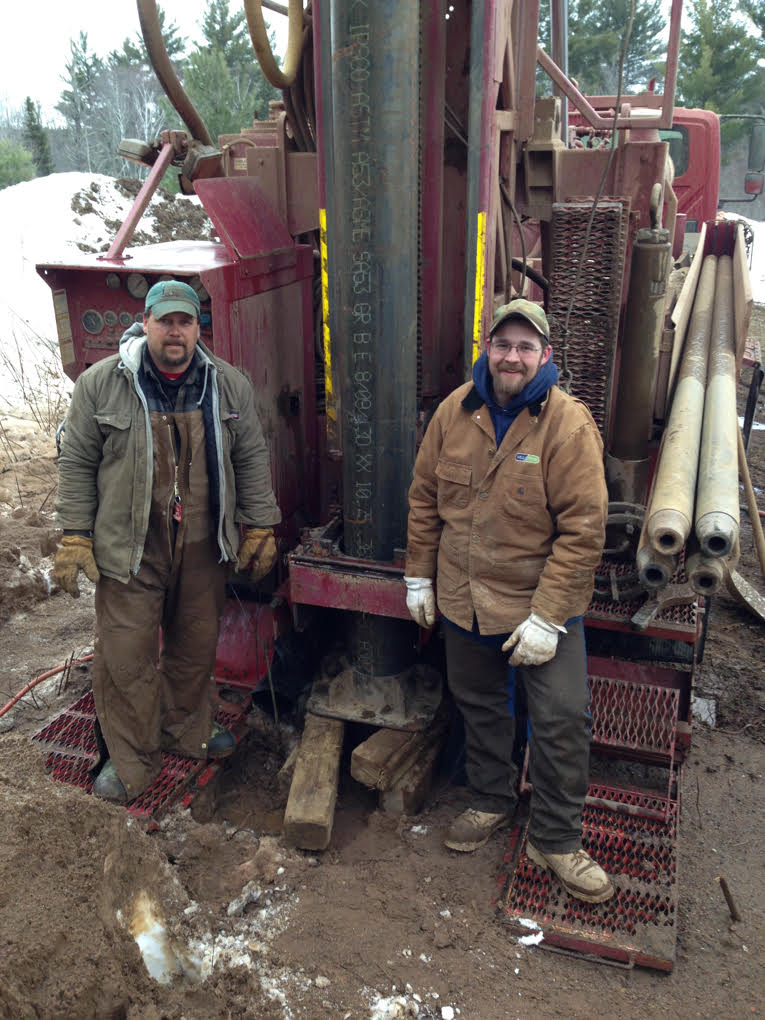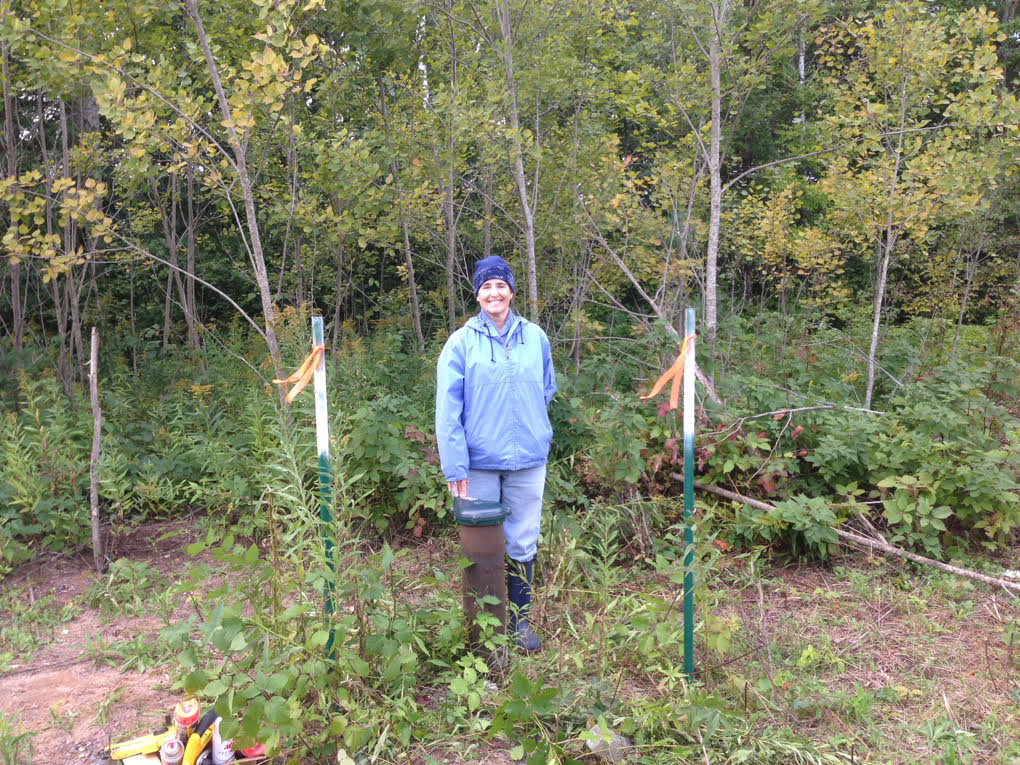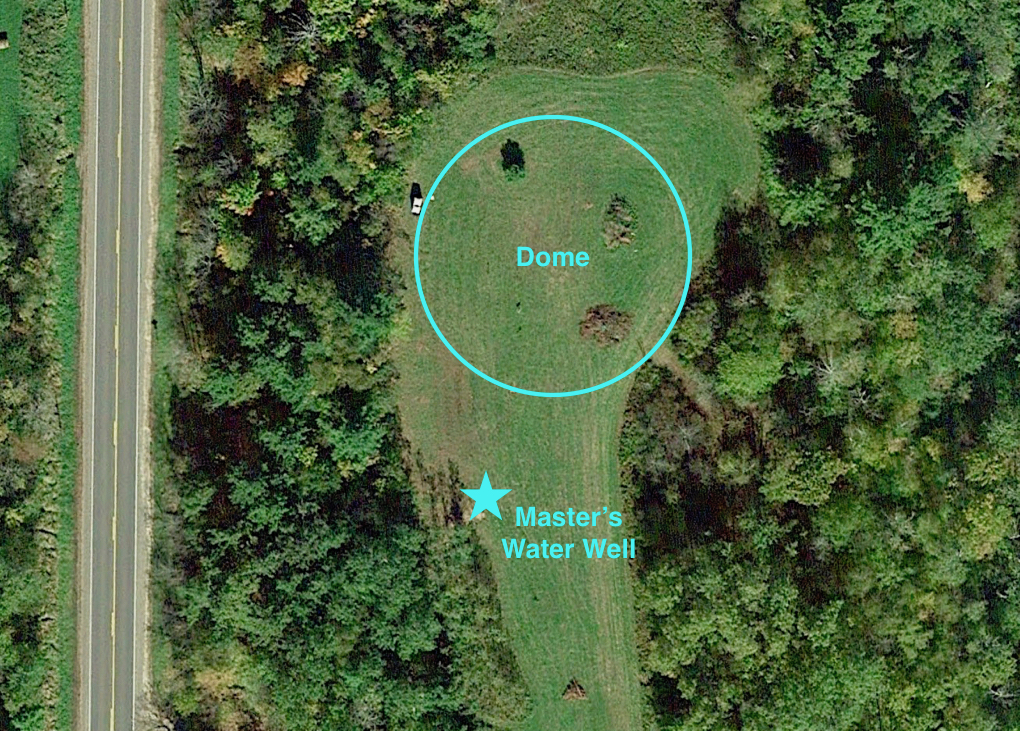Dear Friends,
After retiring from military service in 1889, Baba Jaimal Singh built a small hut for himself in a wild area near the River Beas. His disciples would carry water through the jungle to their Master, from a well that was located a mile distant. Several years after Baba Jaimal Singh initiated Sawan Singh in 1894, Baba Sawan Singh proposed to develop a well near the hut, a simple task for a man trained as a civil engineer. After the well was completed in 1898, the Great Master then received permission to build a small hall for satsang nearby, and the dera grew from there. Thus, Dera Baba Jaimal Singh burst forth from that small, hand-dug well, which still stands.
The original Dera Baba Jaimal Singh water well is shown by blue arrow below.

In a similar way, the first feature to be built at the ISHA Meeting Hall site in Bruce, Wisconsin was the water well, drilled in February of 2014. Before the dome building could be planned, we needed to know that a suitable water supply was available to serve the needs of the building and its 400 occupants. Enough water to supply kitchen cleaning, fire suppression, landscaping, and many simultaneously flushing toilets.
Those of you who have visited the Meeting Hall site might remark that the area has no shortage of water. It’s everywhere … in the nearby rivers, creeks, springs, lakes, and ponds. So how could there be any question that we would not have a good well? As it turns out, nearby wells tend to be poor water producers, and ISHA’s consulting well engineer predicted that it was unlikely that we could find an adequate water supply on ISHA Hill. This is due to the geology of the area, which consists of a thin layer of glacial sediment (sand, gravel, clay) over granite bedrock. But the bedrock is a poor aquifer, and so wherever the sedimentary layer is thin, there’s very little groundwater available to supply a well.
When asked about this, Ishwar told us not to worry, to drill the well on the Hill, and that it would be a good well! And, of course he was right! Our engineer was amazed and delighted that he had drilled such an amazing well.
Ishwar on ISHA Hill near the site of the Meeting Hall water well.

The well was drilled in two days of clear February weather, as a massive snow storm headed into Wisconsin. An onsite satsangi reported that drilling began on the most beautiful day that she’d seen in months. The drillers used a truck-mounted drill rig that could drill at a rate of about 15 feet per hour. Near the end of Day 1, the drillers had reached nearly 80 feet depth, and had encountered some water, but it was murky and therefore of poor quality. They were worried that they would hit bedrock (remember, bedrock is poor aquifer material!) and thus have a failed well. However, the next morning, shortly after drilling commenced, a great cascade of clear water gushed from the drill hole! Success! The driller had never seen such a productive well in this region, with a flow of 100 gallons per minute (much more than needed to supply the ISHA Meeting Hall!).
The bright red drill truck. This is a conventional, mechanical drill rig, where 20-foot sections of steel drill pipe turn a steel drill bit which cuts through the sedimentary strata.

These highly skilled, hardworking drillers did great work for us!

Shortly after the well was completed, the snowstorm hit, dropping over a foot of snow on ISHA Hill, and causing power outages throughout the region.
Here’s a photo of the road to the drill site taken the next day.

The well was drilled to a total depth of 84 feet. The static water level in the well was 48 feet below ground surface. The well is cased with six-inch diameter steel pipe, which can be seen sticking up above the ground in front of the happy satsangi geologist who performed seva during the drilling operation.

As shown on this Google Earth image, the well is located on the south end of ISHA Hill. After construction is completed, the well will actually sit within the circular driveway in front of the Meeting Hall, and a deeply buried pipe will move water from the well into the Dome. Highway 40 is visible on the left.

After the well was completed, the drillers performed a “pump test” in which a temporary pump was lowered into the water column, and the water level in the well was measured as the well pumped water out. This is a critical test, as it indicates whether the well can sustainably supply the project with water. After two hours of pumping at 65 gallons per minute, and one hour of 35 gallons per minute, the water level had stabilized with only a few feet of drawdown, proving that the well can produce plenty of water for our project, even under a high-demand load.
Because the water will be used to supply a large-occupancy building with a commercial kitchen, the water must be regularly tested for contaminants. In March of 2014, a sample of the water was sent to a commercial testing laboratory. The tests showed that the well contains high-quality water, so our water will not require an expensive treatment system!
In the summer of 2016, ISHA had a permanent pump installed in the well, so whenever the project requires fresh water, Master’s Water Well is ready to serve!

With warmest regards,
Paul Bauer
Chair of ISHA Building & Fund-Raising Committee
Paul Bauer
Chair of ISHA Building & Fund-Raising Committee
